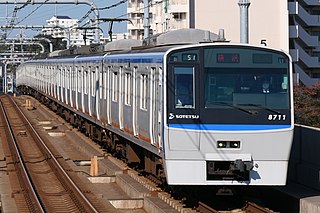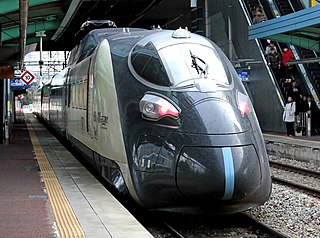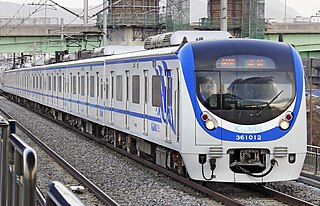
The British Rail Class 82 electric locomotives were designed by the British manufacturing interest Metropolitan-Vickers and produced by Beyer, Peacock and Company on behalf of British Rail (BR).

The DB Class 101 is a class of three-phase electric locomotives built by Adtranz and operated by DB Fernverkehr in Germany. 145 locomotives were built between 1996 and 1999 to replace the 30-year-old and aging Class 103 as the flagship of the Deutsche Bahn, primarily hauling Intercity services. This class encompasses the latest generation of locomotives of the Deutsche Bahn.

EN57 is an electric multiple unit used by the Polish railway operator (PKP). It was built for suburban and long-distance services. Presently it is used by Przewozy Regionalne (Polregio), Łódzka Kolej Aglomeracyjna, SKM Trójmiasto, Koleje Dolnośląskie, Koleje Śląskie and Koleje Mazowieckie companies in Poland.

An electric multiple unit or EMU is a multiple-unit train consisting of self-propelled carriages using electricity as the motive power. An EMU requires no separate locomotive, as electric traction motors are incorporated within one or a number of the carriages. An EMU is usually formed of two or more semi-permanently coupled carriages, but electrically powered single-unit railcars are also generally classed as EMUs. The great majority of EMUs are passenger trains, but versions also exist for carrying mail.

The British Rail Class 302 was a type of electric multiple unit (EMU) introduced between 1958 and 1960 for outer suburban passenger services on the London, Tilbury and Southend line. This class of multiple unit was constructed using the Mark 1 bodyshell and was slam-door.

For servicing suburban commuter lines, electrified on 25 kV, AC, the Railcar Manufacturing Plant of Riga produced ER9, then ER9P and other modifications of electric trainsets in the 1962-2002 period. The mass production of these trains had begun in 1964.

ER2 electric trainset is a DC electric multiple unit which was in production by the Railroad Machinery Plants of Riga from June 1962 to mid-1984. It was essentially an improvement of the ER1 design, featuring footboards for low platforms, and aprons for high platforms, as well as improved electrical equipment and minor changes to the bodywork. Since the mid-1960s, the ER2 has been the most widely used type of suburban train in the Soviet Union and its successor states.

The Tokyo Metro 08 series is an electric multiple unit (EMU) train type operated on the Tokyo Metro Hanzōmon Line in Tokyo, Japan since 2003. Introduced into service on 1 July 2003, a total of six ten-car trainsets were manufactured by Nippon Sharyo between 2002 and 2003 to augment the 8000 series trains following the extension to Oshiage.

E.402A/B is a class of electric locomotives mainly used on medium speed passenger trains by the Italian railway company FS Trenitalia.

The Korail Class 1000 was a series of electric multiple units built in Seoul, South Korea for Seoul Subway Line 1. The cars were built in and entered service between 1974 and 1997. They were gradually retired from the late 1990s to 2020 by newer electric multiple unit trains.

The Korail Class 311000 trains, some train of which were formerly identified as Korail Class 5000 trains, are commuter electric multiple units in South Korea used on Seoul Subway Line 1. Class 311000 trains were manufactured and delivered between 1996 and 2006, and again from 2012 to 2014 to expand service on the Gyeongbu Line and the Gyeongwon Line, and to replace older trains.

The Gyeonggang Line (경강선) is a rail line in South Korea, which at present comprises two distinct sections. The first one, which opened on September 24, 2016, is part of the Seoul Metropolitan Subway system in Gyeonggi-do, South Korea, and runs from the city of Seongnam to Yeoju City, partially coinciding with the route of the former narrow-gauge Suryeo Line. The second section, which is located entirely in Gangwon Province, runs between Gangneung and Wonju and opened on December 22, 2017, in anticipation of the 2018 Winter Olympics. This section of the line offers KTX service from Seoul, through the Jungang Line. In the future, both sections of the lines are to be connected, and the Gyeonggang Line will be extended westwards to Siheung.

The KTX-Sancheon is a South Korean high-speed train built by Hyundai Rotem in the second half of the 2000s and operated by Korail since March 2009. With a top speed of 305 km/h (190 mph), the KTX-Sancheon is the second commercial high-speed train operated in South Korea and the first domestic high-speed train that is designed and developed in South Korea.

The Sotetsu 8000 series (相鉄8000系) is a DC electric multiple unit (EMU) train type operated by the private railway operator Sagami Railway (Sotetsu) in Kanagawa Prefecture, Japan, since 1990.

HEMU-430X is a South Korean high-speed train intended for a maximum speed of 430 km/h (267 mph). On March 31, 2013, it achieved 421.4 km/h in a test run, making South Korea the world's fourth country after France, Japan and China to develop a high-speed train running above 420 km/h. The main new feature of the train compared to older South Korean high-speed trains is distributed traction. The commercial versions of the trains, tentatively named the EMU-260 and EMU-320, were delivered to Korail from 2020–2021.

The Korail Class 321000 trains, created from an assortment of Class 5000, Class 6000, and new cars, are commuter electric multiple units in South Korea used on the Gyeongui-Jungang Line. Class 321000 trains were manufactured and delivered between 2006–2009 to provide service on what was known as the Jungang Line at the time, and to address progressing extensions starting from the extension to Paldang Station.

The Korail Class 331000 trains are commuter electric multiple units in South Korea used on the Gyeongui·Jungang Line. Class 331000 trains were manufactured and delivered in 2009 and from 2012 to 2014 to provide service on the Gyeongui Line and to address progressing extensions starting from the extension to Gongdeok Station.

The Korail Class 361000 trains are commuter electric multiple units in South Korea used on the Gyeongchun Line. Class 361000 trains were manufactured and delivered in 2010 to provide service on the Gyeongchun Line.

The Korail Class 341000 trains, formerly identified as Korail Class 2000 trains, are commuter electric multiple units in South Korea used on Seoul Subway Line 4. Class 341000 trains were manufactured and delivered between 1993 and 1999 to expand service on the Gwacheon Line and the Ansan Line sections of Line 4.

The Korail Class 351000 trains, formerly identified as Korail Class 2000 trains, are commuter electric multiple units in South Korea used on Suin-Bundang Line. Class 351000 trains were manufactured and delivered between 1993.





















